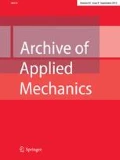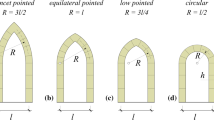Abstract
In this paper, we revisit the limit equilibrium analysis of masonry arches. Firstly, the major contributions during the last three centuries associated with geometric and energy formulations are discussed, and subsequently, the paper explains that the problem of determining the minimum thickness of a masonry arch capable to support its own weight has multiple solutions. The infinite many neighboring solutions for the minimum thickness of a masonry arch result from the infinite many possible directions of rupturing that an arch with finite thickness may develop when becoming a mechanism. Given this infinite number of physically admissible rupturing directions, the energy approach expressed with the principle of stationary potential energy emerges as the most powerful tool to analyze masonry arches at their limit equilibrium state. The paper concludes that vertical rupturing is the most critical rupturing direction since it results to the largest value of the minimum thickness that an elliptical arch needs to support its own weight. For the common case where there is an intrados layer of voussoirs with physical joints perpendicular to the intrados, the initial rupture has to first follow the physical joint; therefore, the broken rupture pattern reported by Lamé and Clapeyron in 1823 corresponds to the larger value of the minimum allowable thickness.
Similar content being viewed by others
References
Sinopoli A., Corradi M., Foce F.: Modern formulation for preelastic theories on masonry arches. J. Eng. Mech. 123, 204–213 (1997). doi:10.1061/(ASCE)0733-9399(1997)123:3(204)
Foce, F., Aita, D.: The masonry arch between “limit” and “elastic” analysis. A critical re-examination of Durand-Claye’s method. In: Proceedings of 1st International Congress on Construction History, (ed. S. Huerta, Madrid: Instituto Juan de Herrera), vol. II, pp. 895–905 (2003)
De Luca A., Giordano A., Mele E.: A simplified procedure for assessing the seismic capacity of masonry arches. Eng. Struct. 26, 1915–1929 (2004). doi:10.1016/j.engstruct.2004.07.003
Lagomarsino S.: On the vulnerability assessment of monumental buildings. Bull Earthq. Eng 4, 445–463 (2006). doi:10.1007/s10518-006-9025-y
Hooke, R.: A description of helioscopes, and some other instruments. London (1675)
Gregory, D.: Catenaria. Philos. Trans. R. Soc. 19, 637–652 (1697). doi:10.1098/rstl.1695.0114
La Hire, P.: Traité de mécanique, où l’on explique tout ce qui est nécessaire dans la pratique des Arts, et les proprietés des corps pesants lesquelles ont eu plus grand usage dans la Physique. Imprimerie Royale, Paris (1695)
La Hire, P.: Sur la construction des voûtes dans les édifices. Mémoires de l’Académie Royale des Sciences, Paris (1731), pp. 69–77 (1712)
Bélidor, B.F.: La science des ingénieurs dans la conduite des travaux de fortification et d’architecture civile. C-A Jombert, Paris (1729)
Couplet, P.: De la poussée des voûtes. Histoire de l’Académie Royale des Sciences, Paris (1731, 1732), pp. 79–117 and pp. 117–141 (1729, 1730)
Danyzy, A.A.H.:Méthode générale pour déterminer la résistance qu’il faut oppose à la poussée des voûtes. Histoire de la Société Royale des Sciences établie à Montpellier, Lyon (1778), vol. II, pp. 40–56(1732)
Frézier, A.F.: La théorie et la pratique de la coupe des pierres et des bois, pour la construction des voûtes et autres parties des bâtimens civils & militaires, ou Traité de stéréotomie, à l’usage de l’architecture. 3 vols, JD Doulksseker le fils, Strasbourg, LH Guerin l’aine, Paris (1737–1739)
Poleni, G.:Memorie istoriche della gran cupola del tempio Vaticano e de’ danni di essa, e de’ ristoramenti loro. Stamperia del Seminario, Padova (1748)
Coulomb, C.A.: Essai sur une application des règles des maximis et minimis à quelques problèmes de statique relatifs à l’arquitecture. Mémoires de mathématique et de physique, présentés à l’académie royal des sciences per divers savants et lus dans ses assemblées, Paris (1776), vol. 7, pp. 343–382 (1773)
Mascheroni, L.: Nuove ricerche sull’equilibrio delle volte. Bergamo (1785)
Boistard, L.C.: Expériences sur la stabilité des voûtes. Recueil de divers mémoires extraits de la bibliothèque impériale des ponts et chaussées a l’usage de MM. les ingénieurs, (ed. P. Lesage), Chez Firmin Didot, Paris, vol. II, pp. 171–217 (1810)
Young T.: A Course of Lectures on Natural Philosophy and the Mechanical Arts, vol. 2. Joseph Johnson, London (1807)
Young, T.: Bridge. Encyclopaedia Britannica (supplement to the 4th, 5th and 6th editions), Archibald Constable, Edinburgh, pp. 497–520(1824)
Lamé M.G., Clapeyron E.: Mémoire sur la stabilité des voûtes. Annales des mines 8, 789–836 (1823)
Persy, N.: Cours sur la stabilité des constructions, à l’usage des élèves de l’école royale de l’Artillerie et du Génie. Lithographie de l’École Royale de l’Artillerie et du Génie, Metz (1825)
Navier, C.L.M.H.:Résumé des Leçons données à l’École des Ponts et Chaussées sur l’application de la mécanique à l’établissement des constructions et des machines. Dibot, Paris (1826)
Culmann K.: Die graphische Statik. Verlag von Meyer und Zeller, Zurich (1866)
Durand-Claye A.: Note sur la vérification de la stabilité des voûtes en maçonnerie et sur l’emploi des courbes de pression. Annales des Ponts et Chaussées 13, 63–93 (1867)
Milankovitch, M.: Beitrag zur Theorie der Druckkurven. Dissertation zur Erlangung der Doktorwürde, K.K. technische Hochschule, Vienna (1904)
Milankovitch M.: Theorie der Druckkurven. Zeitschrift für Mathematik und Physik 55, 1–27 (1907)
Clemente P., Occhiuzzi A., Raithel A.: Limit behavior of stone arch bridges. J. Struct. Eng. 121, 1045–1050 (1995). doi:10.1061/(ASCE)0733-9445(1995)121:7(1045)
Sinopoli, A.: The role of geometry in the theories on vaulted structures by Lorenzo Mascheroni. In: Proceedings of 1st International Congress on Construction History, (ed. S. Huerta, Madrid: Instituto Juan de Herrera), pp. 1865–1873(2003)
Ochsendorf, J.: Collapse of masonry structures. Ph.D. Dissertation, Department of Engineering, University of Cambridge, Cambridge, UK (2002)
Makris N., Alexakis H.: The effect of stereotomy on the shape of the thrust-line and the minimum thickness of semicircular masonry arches. Arch. Appl. Mech. 83, 1511–1533 (2013). doi:10.1007/s00419-013-0763-4
Alexakis H., Makris N.: Minimum thickness of elliptical masonry arches. Acta. Mech. 224, 2977–2991 (2013). doi:10.1007/s00707-013-0906-2
Alexakis, H., Makris, N.: Limit equilibrium analysis and the minimum thickness of circular masonry arches to withstand lateral inertial loading. Arch. Appl. Mech., published on line. doi:10.1007/s00419-014-0831-4 (2014)
Lagrange, J.L.: Mécanique analytique. Chez La Veuve Desaint, Libraire, Paris(1788)
Heyman J.: The safety of masonry arches. Int. J. Mech. Sci. 11, 363–385 (1969). doi:10.1016/0020-7403(69)90070-8
Heyman J.: The Masonry Arch. Ellis Horwood, Chichester (1982)
Heyman, J.: La Coupe des Pierres. In: Proceedings of 3rd International Congress on Construction History, (eds. Kurrer KE, Lorenz W, Wetzk V), Neunplus1, Berlin, 2, pp. 807–812 (2009)
Bićanić N., Stirling C., Pearce C.J.: Discontinuous modelling of masonry bridges. Comput. Mech. 31, 60–68 (2003). doi:10.1007/s00466-002-0393-0
Foce F.: Milankovitch’s Theorie der Druckkurven: Good mechanics for masonry architecture. Nexus Netw. J. 9, 185–210 (2007). doi:10.1007/s00004-007-0039-9
Rizzi E., Cocchetti G., Colasante G., Rusconi F.: Analytical and numerical analysis on the collapse mode of circular masonry arches. Adv. Mater. Res. 133(134), 467–472 (2010). doi:10.4028/www.scientific.net/AMR.133-134.467
Heyman J.: Coulomb’s Memoir on Statics: An Essay in the History of Civil Engineering. Cambridge University Press, Cambridge (1972)
Delbecq J.M.: Analyse de la stabilité des voûtes en maçonnerie de Charles Augustin Coulomb à nos jours. Annales des Ponts et Chaussées 19, 36–43 (1981)
Delbecq J.M.: Analyse de la stabilité des voûtes en maçonnerie par le calcul à la rupture. J. de Mécanique théorique et appliquée 1, 91–121 (1982)
Delbecq J.M.: Les Ponts en Maçonnerie – Constitution et Stabilité. Ministère des Transports. SETRA, Paris (1982)
Roca P., Cervera M., Gariup G., Pela’ L.: Structural analysis of masonry historical constructions. Classical and advanced approaches. Arch. Comput. Methods Eng. 17, 299–325 (2010). doi:10.1007/s11831-010-9046-1
Huerta, S., Foce, F.: Vault theory in Spain between XVIIIth and XIXth century: Monasterio’s unpublished manuscript Nueva teorica sobre el empuje de bóvedas. In: Proceedings of 1st International Congress on Construction History, (ed. S. Huerta, Madrid: Instituto Juan de Herrera), vol. II, pp. 1155–1166 (2003)
Foce, F.: On the safety of the masonry arch. Different formulations from the history of structural mechanics. In: Essays in the History of Theory of Structures, (ed. S. Huerta, Madrid: Instituto Juan de Herrera), pp. 117–142 (2005)
Albuerne, A., Huerta, S.: Coulomb’s theory of arches in Spain ca. 1800: the manuscript of Joaquín Monasterio. In: Proceedings of 6th International Conference on Arch Bridges (ARCH’10), (ed. B. Chen & J. Wei), Fuzhou, China, pp. 354–362 (2010)
Timoshenko S.P.: History of Strength of Materials. McGraw-Hill Book Company, Inc., New York (1953)
Moseley, H.: The Mechanical Principles of Engineering and Architecture, London (1843)
Huerta, S.: Wedges and plate-bandes: mechanical theories after De la Hire. In: L’architrave, le plancher, la plate-forme. Nouvelle histoire de la construction, under the direction of Roberto Gargiani, PPUR Presses polytechniques et universitaires romandes, Lausanne, pp. 405–435 (2012)
Alexakis H., Makris N.: Structural stability and bearing capacity analysis of the tunnel-entrance to the stadium of ancient nemea. Int. J. Arch. Her. 7, 673–692 (2013). doi:10.1080/15583058.2012.662262
Varma M., Jangid R.S., Ghosh S.: Thrust line using linear elastic finite element analysis for masonry structures. Adv. Mater. Res. 133(134), 503–508 (2010). doi:10.4028/www.scientific.net/AMR.133-134.503
Loo Y.C., Yang Y.: Cracking and failure analysis of masonry arch bridges. J. Struct. Eng. 117, 1641–1659 (1991). doi:10.1061/(ASCE)0733-9445(1991)117:6(1641)
Molins C., Roca P.: Capacity of masonry arches and spatial frames. J. Struct. Eng. 124, 653–663 (1998). doi:10.1061/(ASCE)0733-9445(1998)124:6(653)
Thavalingam A., Bicanic N., Robinson J.I., Ponniah D.A.: Computational framework for discontinuous modelling of masonry arch bridges. Comput. Struct. 79, 1821–1830 (2001). doi:10.1016/S0045-7949(01)00102-X
Lourenço P.B.: Computation on historic masonry structures. Prog. Struct. Eng. Mater. 4, 301–319 (2002). doi:10.1002/pse.120
Cavicchi A., Gambarotta L.: Two-dimensional finite element upper bound limit analysis of masonry bridges. Comput. Struct. 84, 2316–2328 (2006). doi:10.1016/j.compstruc.2006.08.048
Drosopoulos G.A., Stavroulakis G.E., Massalas C.V.: Limit analysis of a single span masonry bridge with unilateral frictional contact interfaces. Eng. Struct. 28, 1864–1873 (2006). doi:10.1016/j.engstruct.2006.03.016
Milani E., Milani G., Tralli A.: Limit analysis of masonry vaults by means of curved shell finite elements and homogenization. Int. J. Solids Struct. 45, 5258–5288 (2008). doi:10.1016/j.ijsolstr.2008.05.019
Author information
Authors and Affiliations
Corresponding author
Rights and permissions
About this article
Cite this article
Alexakis, H., Makris, N. Limit equilibrium analysis of masonry arches. Arch Appl Mech 85, 1363–1381 (2015). https://doi.org/10.1007/s00419-014-0963-6
Received:
Accepted:
Published:
Issue Date:
DOI: https://doi.org/10.1007/s00419-014-0963-6




